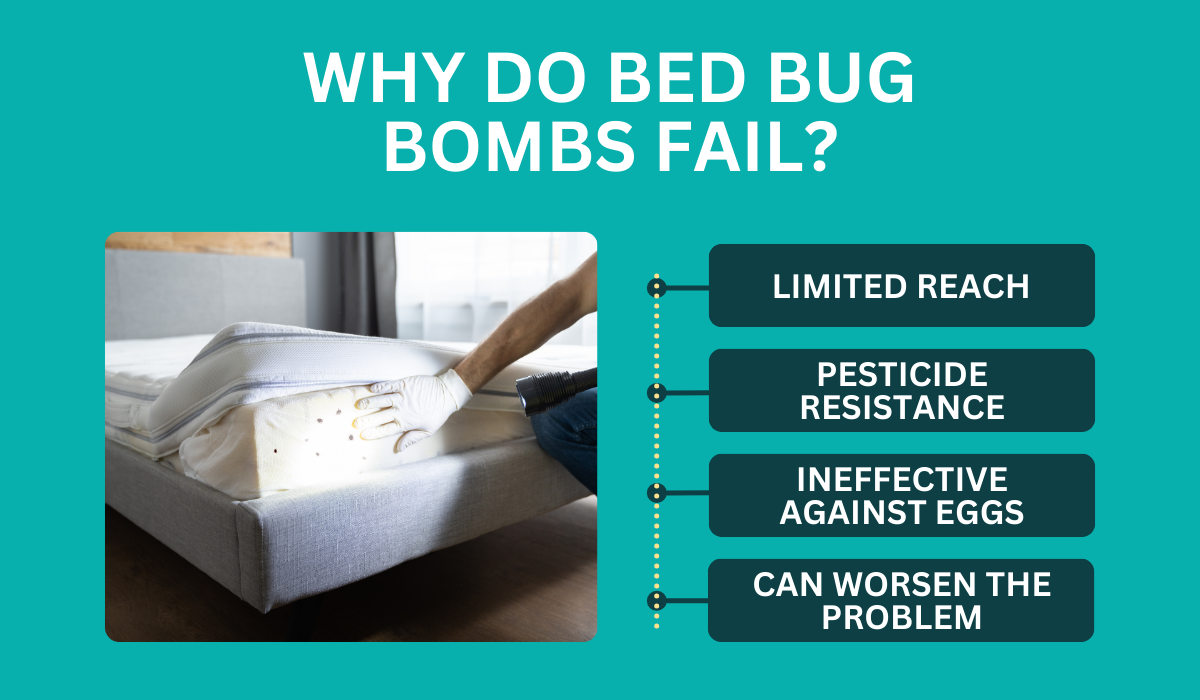Do Bed Bug Bombs Work? Here’s What to Know
Bed bug infestations can be a nightmare, and many people turn to bed bug bombs as a solution. But do bed bug bombs actually work?
While bed bug bombs might seem like an easy fix, their effectiveness is often questioned.
If you're grappling with a bed bug problem and wondering if foggers are the answer, read on.
Key Takeaways
- Bed bug bombs aim to fill rooms with insecticide mist to reach hiding spots but often fail due to pests’ hiding abilities and pesticide resistance.
- Marketed as simple fixes, these bombs miss deep hideouts and eggs, potentially causing infestations to rebound.
- Using bed bug bombs poses risks, including health reactions, fire hazards, environmental damage, and misuse, which can worsen the effects.
- Effective alternatives include mattress encasements, interceptors, and professional pest control, which offer thorough, targeted elimination.
How Do Bed Bug Bombs Work?
Bed bug bombs, also known as foggers or total-release foggers, are designed to tackle infestations. These products usually come in aerosol cans containing insecticides, often pyrethroids.
The idea is simple: when the bomb is activated, it releases a mist that spreads throughout the room, aiming to kill bed bugs on contact. Here’s how it’s typically done:
Preparation: Clean the area and remove pets and food.
Placement: Place the bed bug bomb in the center of the room.
Activation: Press the nozzle to release the insecticide mist.
Dispersion: The mist fills the room, ideally reaching cracks and crevices where bed bugs hide.
Ventilation: After the prescribed time, ventilate the area by opening windows and doors.
Ideal Scenarios
Using bed bug bombs can be straightforward if conditions align well with these ideal scenarios. Ideally, they work best when used in these scenarios:
Ideal Scenarios for Use | Description |
Small, enclosed areas | Works best in confined spaces. |
Minor or light infestations | More effective when bed bug numbers are low. |
Clean and clutter-free area | Allows the mist to reach hidden bugs. |
Why Do Bed Bug Bombs Fail?

Bed bug bombs often fail to get rid of bed bug infestations due to several critical factors.
Limited Reach
Bed bug bombs struggle with reaching the small hiding spots where bed bugs often reside. These pests are skilled at hiding in crannies, crevices, and other tight spaces that the fog from the bombs cannot penetrate effectively.
This limitation prevents the bombs from effectively treating mattresses, couches, bed frames, box springs, baseboards, and behind headboards.
Pesticide Resistance
Many bed bugs have developed resistance to the pesticides used in bed bug bombs over the years. This resistance means that even if the bomb reaches the insects, it might not kill them.
Entomologists at Ohio State University have observed and documented this resistance. Their entomology studies have shown that bed bugs in some regions are no longer susceptible to common pesticides found in these foggers.
Ineffective Against Eggs
Foggers fail to affect bed bug eggs, often hidden deep within crevices and other protected areas. They’re resilient and require direct contact with insecticides to be destroyed.
However, the eggs frequently remain intact since foggers only work on exposed surfaces. Once the eggs hatch, this results in a resurgence of adult bed bugs.
Can Worsen the Problem
Using bed bug bombs can sometimes worsen the infestation. The fog can cause bed bugs to scatter and retreat deeper into harder-to-reach areas, such as inside walls, baseboards, and closets.
This displacement makes subsequent treatment more difficult and allows bed bugs to continue spreading to new areas within the home.
The Risks of Using Bed Bug Bombs
Often marketed as quick DIY solutions to treat bed bugs, foggers come with several risks.
Health Concerns: The chemical concentrations in these bombs can cause respiratory problems, skin irritations, and other allergic reactions, especially in people with pre-existing conditions.
Pilot Lights and Fire Hazards: Using bed bug bombs near pilot lights or open flames poses a fire risk. These highly flammable products can ignite easily, and a small spark can lead to a dangerous situation.
Waste of Time and Money: Many homeowners find bed bug bombs ineffective. They often fail to reach the insects hiding in cracks and crevices, wasting time and financial resources.
Environmental Impact: The chemicals released by flea foggers and bed bug foggers can also harm the environment, affecting indoor and outdoor air quality.
Potential for Misuse: DIY treatments can sometimes lead to improper use. Overusing or incorrectly applying these bombs may increase health risks and decrease effectiveness.
Residue Issues: The residue left behind by these bombs can contaminate surfaces, including food preparation areas, posing a risk to household safety and hygiene.
When to Call a Professional
Sometimes, handling a bed bug infestation gets tricky. If bed bugs keep coming back after DIY treatments like diatomaceous earth or washing washable items in hot water, calling a professional pest control company (like us at Native Pest Management) makes sense.
As professionals, we ensure safer and more effective results for your pest problems. So, it’s better to let us handle it, as we have the skills and tools to get the job done right.
